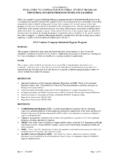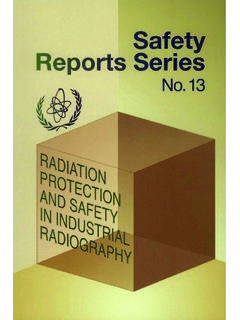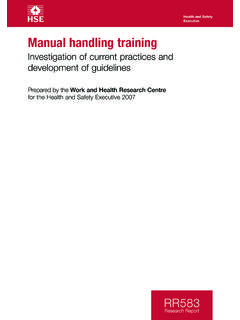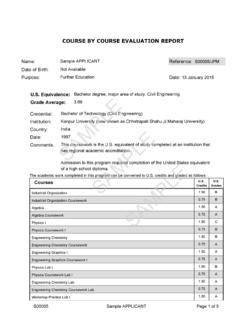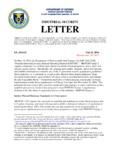Transcription of INDUSTRIAL TRAINING REPORT - 三重大学
1 INDUSTRIAL TRAINING REPORT NORANIZA BINTI AHMAD DAUD BACHELOR OF SCIENCE (HONS) MAJOR IN CHEMISTRY FACULTY OF SCIENCE UNIVERSITY OF PUTRA MALAYSIA CENTER FOR INTERNATIONAL EDUCATION AND RESEARCH FOOD CHEMISTRY, BIOMASS GRADUATE SCHOOL OF REGIONAL INNOVATION STUDIES MIE UNIVERSITY DATE OF INDUSTRIAL TRAINING : 1st JULY till 24th AUGUST 2013 ACKNOWLEDGEMENT It is always a pleasure to remind the fine people in the MIE University for their sincere guidance I received to uphold my practical as well as laboratory skills in Chemistry. First of all, thanks to my parent for giving encouragement, enthusiasm and invaluable assistance to me. Without all this, I might not be able to complete this subject properly.
2 Second, I would like to thanks to Dr. Nor Azowa Ibrahim, Deputy Dean (Academic, SA and Alumni Division) for give us the opportunity to undergo INDUSTRIAL TRAINING abroad. She also gives me their guidance and support. Thirdly, I also want to express my deepest thanks to Dr. Norhazlin Zainuddin as industry TRAINING advisory for Chemistry Department that has helped me a lot in dealing with INDUSTRIAL TRAINING placement. She had supported to me by showing different method of information collection about the University. She helped all time when we needed and she gave right direction toward completion of project. Besides, I would like to thank Prof Takashi Mishima (Head and Senior Lecturer/Department of Bioresearch), Koutatsu Sakakura, Budi santoso, Toshihito Yuri, and also Shigetaro Arita (Teaching Assistant) of Bioresearch Laboratory for extending their friendship towards me and making a pleasure- TRAINING environment in the Bioresearch Laboratory.
3 Thanks also to Miss Mika Deguchi as a person in charge of international relations office of Mie University which has helped to manage matters related to this TRAINING industry. A paper is not enough for me too express the support and guidance I received from them almost for all the work I did there. Finally I apologize all other unnamed who helped me in various ways to have a good TRAINING . 2 TABLE OF CONTENT No. Title Page1 Acknowledgement 2 2 Introduction 4 Activity 3 5 Analysis in Laboratory 5 Others Activity 6 HPLC 7 Phenol Sulphuric Acid 7 Amino Acid Detection 4 Project (Analysis of Content in Fruit & Vegetables) 8 8 Objective 8 Introduction 8 Method 10 Result & Discussion 11 5 Suggestion 6 Conclusion 11 3 INTRODUCTION Being the only national university located within Mie Prefecture, it has provided wide variety of departments, from science to humanities.
4 The Graduate School of Bioresources contains an independent graduate course focused on the foundation of bioresources. The Graduate School of Bioresources has a master's program for students who aspire to continue their studies after graduating from the undergraduate program and a doctoral program for those who wish to enrich their studies even further. This school also offers the worker special selection exam that engineers and researchers, who work in various institutions and businesses, can take to become eligible to enter the university. This school proactively promotes the acceptance of international exchange and foreign exchange students from counties all around the world.
5 In collaboration with Universiti Putra Malaysia, we have go there to undergo INDUSTRIAL TRAINING to enhance the skills laboratory and also in preparation for the working soon. I have done doing my INDUSTRIAL TRAINING at the Graduate School of Bioresources at Mie University of Japan that began from 1st July 2013 until 24th August 2013. For being there, I have been trained to analyse some ingredients in foods such as carbohydrate and amino acid. We have learned some dilution method. We also been introduced with many way to determine the total concentration of carbohydrates present in foods for example by using HPLC machine or by using phenol sulphuric acid method.
6 Besides that, we manage to use the HPLC and UV machine properly. We also participate some activity that had been organised by university. At last, we had been run one project which is to analysed the food contents. 4 ANALYSIS IN LABORATORY 1. DILUTION/PREPARATION SAMPLE Generally, we are trained to prepare the solution of different type of sugar with different concentration. Usually we will use this basic formula; M1V1=M2V2 OTHERS ACTIVITY SCIENCE SHOW 1. Bubble solution SET A PVA Distilled water Glycerin Soap SET B PVA Distilled water Sucrose Soap 2. Liquid Nitrogen with balloon At first, prepare the balloon.
7 Then soak the balloon into the liquid nitrogen. The balloon will be shrink. After we take out again the balloon from the box, it will expand again as before. 5 HPLC Liquid chromatography (LC) is a method of a separation which employs a liquid mobile phases and either a solid or liquid immobilized on a solid. A liquid may be immobilized on the solid by chemical reaction with the solid, by reaction to form an insoluble polymer deposited on the surface or it may be a liquid that is insoluble in the mobile phases to be used. Liquid-chromatography was usually to separate and isolate variety of compounds. HPLC have several types of detector which are based on Refractive index measurement and UV detectors.
8 Mobile Phases Common mobile phase uses include any miscible combination of water with various organic solvents for example acetonitrile and methanol. The composition of mobile phases may be kept constant (isocratic mode) or varied (gradient mode) during the analysis. When changing new mobile phase, it is hard to get the same concentration as before and it may change the retention time. So as the precaution step, we need to analyse using the same mobile phase. The UV Detector There are several ways to detect substances when it passed through the column. One of it is by uses ultra-violet absorption. Generally, most organic compounds absorb UV light of different wavelengths.
9 If we have a beam of UV light shining through the stream of liquid that coming out from the column, and the UV detector is located in front of the stream, easily we can get a direct reading of how much of the light had been absorbed. In addition, the solvent or mobile phases will also absorb the UV light but it differ as the other compounds as the different compound will absorb more strongly in different parts of the UV spectrum. We had used this detector to measure the amino acid present in the sample. We cannot use this detector to analyse sugar because sugar don t absorb UV light due to don t possess chromophore in their structure. So for measuring the sugar, usually we used the refractive index detector.
10 6 The Refractive Index Detector This detector's sensitivity is limited. This detector can be very useful for detecting those compounds that are non-ionic, do not adsorb in the UV, and do not fluoresce. This is a property of all liquids and solids through which light can pass. As the light passes through the material, the beam is refracted and the extent of this refraction is measured by the Refractive Index. PHENOL SULPHURIC ACID METHOD The phenol-sulphuric acid method is an example of a colorimetric method that had been used to determine the total concentration of sugar present in food. First, the clear solution of sugar that wants to analyse was placed in a test tube.



